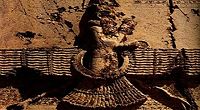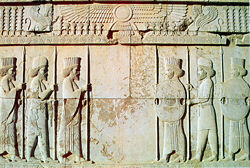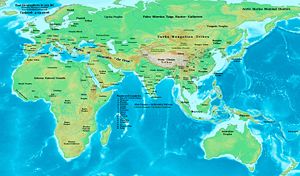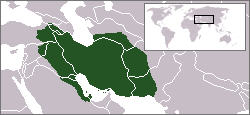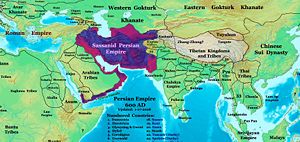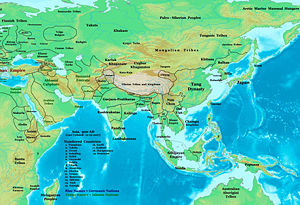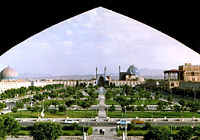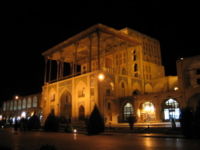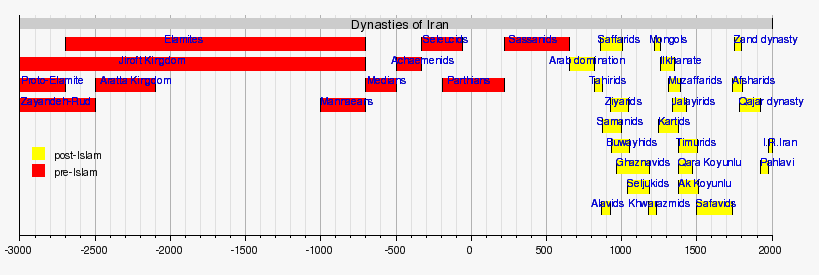Persian Empire
2008/9 Schools Wikipedia Selection. Related subjects: Ancient History, Classical History and Mythology
|
The Persian Empire was a series of Iranian empires that ruled over the Iranian plateau, the original Persian homeland, and beyond in Western Asia, Central Asia and the Caucasus.
The most widespread entity considered to have been a Persian Empire was the Achaemenid Empire (550–330 BC) under Darius and Xerxes (or Xerkes) — famous in antiquity as the foe of the classical Greek states (See Greco-Persian Wars) — a united Persian kingdom that originated in the region now known as Pars province (Fars province) of Iran.
It was formed under Cyrus the Great, who took over the empire of the Medes, and conquered much of the middle east, including the territories of the Babylonians, Assyrians, the Phoenicians, and the Lydians. Cambyses, Son of Cyrus the Great, continued his conquests by conquering Egypt. The Persian Empire is thought to have been taken over by Alexander the Great.
Most of the successive states in Greater Iran prior to March 1935 are collectively called the Persian Empire by Western historians.
Virtually all the successor empires of Persia were major regional and some major international powers in their day.
History
Achaemenid Empire (550 BC–330 BC)
The earliest known record of the Persians comes from an Assyrian inscription from c. 844 BC that calls them the Parsu (Parsuaš, Parsumaš) and mentions them in the region of Lake Urmia alongside another group, the Mādāyu ( Medes). For the next two centuries, the Persians and Medes were at times tributary to the Assyrians. The region of Parsuash was annexed by Sargon of Assyria around 719 BC. Eventually the Medes came to rule an independent Median Empire, and the Persians were subject to them.
The Achaemenids were the first to create a centralized state in Persia, founded by Achaemenes (Haxamaniš), chieftain of the Persians around 700 BC.
Around 653 BC, the Medes came under the domination of the Scythians, and Teispes (Cišpiš), the son of Achaemenes, seems to have led the nomadic Persians to settle in southern Iran around this time — eventually establishing the first organized Persian state in the important region of Anšan as the Elamite kingdom was permanently destroyed by the Assyrian ruler Ashurbanipal (640 BC). The kingdom of Anšan and its successors continued to use Elamite as an official language for quite some time after this, although the new dynasts spoke Persian, an Indo-Iranian tongue.
Teispes' descendants may have branched off into two lines, one line ruling in Anshan, while the other ruled the rest of Persia. Cyrus II the Great (Kuruš) united the separate kingdoms around 559 BC. At this time, the Persians were still tributary to the Median Empire ruled by Astyages. Cyrus rallied the Persians together, and in 550 BC defeated the forces of Astyages, who was then captured by his own nobles and turned over to the triumphant Cyrus, now Shah of a unified Persian kingdom. As Persia assumed control over the rest of Media and their large empire, Cyrus led the united Medes and Persians to still more conquest. He took Lydia in Asia Minor, and carried his arms eastward into central Asia. Finally in 539 BC, Cyrus marched triumphantly into the ancient city of Babylon. After this victory, he set the standards of a benevolent conqueror by issuing the Cyrus Cylinder, the first charter of human rights. Cyrus was killed in 530 BC during a battle against the Massagetae or Sakas.
Cyrus's son, Cambyses II (Kambūjiya), annexed Egypt to the Achaemenid Empire. The empire then reached its greatest extent under Darius I (Dāryavuš). He led conquering armies into the Indus River valley and into Thrace in Europe. A punitive raid against Greece was halted at the Battle of Marathon. A larger invasion by his son, Xerxes I (Xšayārša), would have initial success at the Battle of Thermopylae. Following the destruction of his navy at the Battle of Salamis, Xerxes would withdraw most of his forces from Greece. The remnant of his army in Greece commanded by General Mardonius was ultimately defeated at the Battle of Plataea in 479 BC.
Darius divided his realm into twenty-three satrapies (provinces) supervised by satraps, or governors, many of whom had personal ties to the Shah. He instituted a systematic tribute to tax each province. He took the advanced postal system of the Assyrians and expanded it. Also taken from the Assyrians was the usage of secret agents of the king, known as the King's Eyes and Ears, keeping him informed.
Darius improved the famous Royal Road and other ancient trade routes, thereby connecting far reaches of the empire. He may have moved the administration centre from Fars itself to Susa, near Babylon and closer to the centre of the realm. The Persians allowed local cultures to survive, following the precedent set by Cyrus the Great. This was not only good for the empire's subjects, but ultimately benefited the Achaemenids, because the conquered peoples felt no need to revolt.
It may have been during the Achaemenid period that Zoroastrianism reached South-Western Iran, where it came to be accepted by the rulers and through them became a defining element of Persian culture. The religion was not only accompanied by a formalization of the concepts and divinities of the traditional (Indo-)Iranian pantheon, but also introduced several novel ideas, including that of free will, which is arguably Zoroaster's greatest contribution to religious philosophy. Under the patronage of the Achaemenid kings, and later as the de-facto religion of the state, Zoroastrianism would reach all corners of the empire. In turn, Zoroastrianism would be subject to the first syncretic influences, in particular from the Semitic lands to the west, from which the divinities of the religion would gain astral and planetary aspects and from where the temple cult originates. It was also during the Achaemenid era that the sacerdotal Magi would exert their influence on the religion, introducing many of the practices that are today identified as typically Zoroastrian, but also introducing doctrinal modifications that are today considered to be revocations of the original teachings of the prophet.
The Achaemenid Empire united people and kingdoms from every major civilization in south West Asia and North East Africa.
Hellenistic Persia (330 BC–250 BC)
The Achaemenid dynasty never managed to conquer Greece, but often supported one side or the other in wars between the individual Greek states. However, the Achaemenid Empire's weakness was exposed to the Greeks in 401 BC, when a rebel prince, Cyrus the Younger, hired thousands of Greek mercenaries to help secure his claim to the imperial throne (see Xenophon, Anabasis). This army (known as the Ten thousand) marched all the way into the heart of Persia and back again. This demonstrated the military problems of the Achaemenid forces when dealing with the highly effective Greek phalanx. (A densely packed unit of men armed with long pikes or spears)
Philip II of Macedon managed to unify most of Greece and the balkans under his control, and decided to take advantage of Achaemenid weakness when, after the death of Artaxerxes (Artaxšaçrā) III Ochus in 338 BC, the Persian Empire had no strong leader. On Philip's death in 336 BC, his son and heir Alexander continued the attack on the Empire. He turned out to be one of the greatest generals in history. The Achaemenid monarch, Darius III was an aged man with a reputation for bravery gained in his youth, but in the event was no match for Alexander. Against the highly professional Greek standing army, Persia, the greatest empire of the age collapsed in only eight years.
Alexander landed in Asia Minor in 334 BC. His armies quickly swept through Lydia, Phoenicia, and Egypt, before defeating Darius III at Gaugamela (331 BC) and capturing the capital at Susa. The last Achaemenid resistance was at the " Persian Gates" between Susa and near the royal palace at Persepolis. The Achaemenid Empire was now in Alexander's hands.
Along his route of conquest, Alexander founded many colony cities, often named "Alexandria". For the next several centuries, these cities served to greatly extend Greek, or Hellenistic, culture in Persia.
Alexander's empire broke up shortly after his death, and Alexander's general, Seleucus I Nicator, tried to take control of Persia, Mesopotamia, and later Syria and Asia Minor. His ruling family is known as the Seleucid Dynasty. However he was killed in 281 BC by Ptolemy Keraunos before he could conquer Greece and Macedonia.
Greek colonization continued until around 250 BC; Greek language, philosophy, and art came with the colonists. Throughout Alexander's former empire, Greek became the common tongue of diplomacy and literature. Trade with China had begun in Achaemenid times along the so-called Silk Road; but during the Hellenistic period it began in earnest. The overland trade brought about some fascinating cultural exchanges. Buddhism came in from India, while Zoroastrianism traveled west to influence Judaism. Incredible statues of the Buddha in classical Greek styles have been found in Persia and Afghanistan, illustrating the mix of cultures that occurred around this time (See Greco-Buddhism), although it is possible that Greco-Buddhist art dates from Achaemenid times when Greek artists worked for the Persians.
Although recently discovered cuneiform evidence (e.g., the Babylonian Chronicles from the Hellenistic Period) show how much continuity there was in the Eastern civilization, it can not be denied that the Seleucid kingdom began to decline after about a century. The eastern provinces of Bactria and Parthia broke off in 238 BC. King Antiochus III's military leadership kept Parthia from overrunning Persia itself, but when he tried to intervene in Greece, his successes alarmed the burgeoning Roman Republic. Roman legions began to attack the kingdom. At the same time, the Seleucids had to contend with the revolt of the Maccabees in Judea and the expansion of the Kushan Empire to the east. The empire fell apart and was conquered by Parthia and Rome.
Parthians (250 BC–AD 226)

Its rulers, the Arsacid dynasty, belonged to an Iranian tribe that had settled there during the time of Alexander. They declared their independence from the Seleucids in 238 BC, but their attempts to unify Iran were thwarted until after the advent of Mithridates I to the Parthian throne in about 170 BC.
The Parthian Confederacy shared a border with Rome along the upper Euphrates River. The two polities became major rivals, especially over control of Armenia. Heavily-armoured Parthian cavalry ( cataphracts) supported by mounted archers proved a match for Roman legions, as in the Battle of Carrhae in which the Parthian General Surena defeated Marcus Licinius Crassus of Rome. Wars were very frequent, with Mesopotamia serving as the battleground.
During the Parthian period, Hellenistic customs partially gave way to a resurgence of Iranian culture. However, the area lacked political unity, and the vassalary structure that the Arsacids had adopted from the Seleucids left the Parthians in a constant state of war with one seceding vassal or the other. By the 1st century BC, Parthia was decentralized, ruled by feudal nobles. Wars with Romans to the west and the Kushan Empire to the northeast drained the country's resources.
Parthia, now impoverished and without any hope of recovering its lost territories, was demoralized. The kings had to give more concessions to the nobility, and the vassal kings sometimes refused to obey. Parthia's last ruler Artabanus IV had an initial success in putting together the crumbling state. However, the fate of the Arsacid Dynasty was doomed when in AD 224, the Persian vassal king Ardashir revolted. Two years later, he took Ctesiphon, and this time, it meant the end of Parthia. It also meant the beginning of the second Persian Empire, ruled by the Sassanid kings. Sassanids were from the province of Persis, native to the first Persian Empire, the Achaemenids.
Sassanid Empire (226–651)
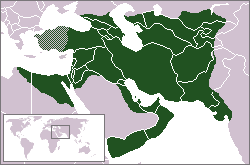
The Sassanid Empire or Sassanian Dynasty ( Persian: ساسانیان, pronounced [sɒsɒnijɒn]) is the name used for the fourth imperial Iranian dynasty, and the second Persian Empire (226–651). The Sassanid dynasty was founded by Ardashir I after defeating the last Parthian (Arsacid) king, Artabanus IV ( Persian: اردوان Ardavan) and ended when the last Sassanid Shahanshah (King of Kings), Yazdegerd III (632–651), lost a 14-year struggle to drive out the early Islamic Caliphate, the first of the Islamic empires.
Ardashir I led a rebellion against the Parthian Confederacy in an attempt to revive the glory of the previous empire and to legitimize the Hellenized form of Zoroastrianism practised in southwestern Iran. In two years he was the Shah of a new Persian Empire.
The Sassanid dynasty (also Sassanian, named for Ardashir's grandfather) was the first dynasty native to the Pars province since the Achaemenids; thus they saw themselves as the successors of Darius and Cyrus. They pursued an aggressive expansionist policy. They recovered much of the eastern lands that the Kushans had taken in the Parthian period. The Sassanids continued to make war against Rome; a Persian army even captured the Roman Emperor Valerian in 260.
The Sassanid Empire, unlike Parthia, was a highly centralized state. The people were rigidly organized into a caste system: Priests, Soldiers, Scribes, and Commoners. Zoroastrianism was finally made the official state religion, and spread outside Persia proper and out into the provinces. There was sporadic persecution of other religions. The Eastern Orthodox Church was particularly persecuted, but this was in part due to its ties to the Roman Empire. The Nestorian Christian church was tolerated and sometimes even favored by the Sassanids.
The wars and religious control that had fueled the Sassanid Empire's early successes eventually contributed to its decline. The eastern regions were conquered by the White Huns in the late 5th century. Adherents of a radical religious sect, the Mazdakites, revolted around the same time. Khosrau I was able to recover his empire and expand into the Christian countries of Antioch and Yemen. Between 605 and 629, Sassanids successfully annexed Levant and Roman Egypt and pushed into Anatolia.
However, a subsequent war with the Romans utterly destroyed the empire. In the course of the protracted conflict, Sassinid armies reached Constantinople, but could not defeat the Byzantines there. Meanwhile, the Byzantine Emperor Heraclius had successfully outflanked the Persian armies in Asia Minor and attacked the empire from the rear while the main Iranian army along with its top Eran Spahbods were far from battlefields. This resulted in a crushing defeat for Sassanids in Northern Mesopotamia. The Sassanids had to give up all their conquered lands and retreat.
Following the advent of Islam and collapse of Sassanid Empire, Persians came under the subjection of Arab rulers for almost two centuries before native Persian dynasties could gradually drive them out. In this period a number of small and numerically inferior Arab tribes migrated to inland Iran.
Also some Turkic tribes settled in Persia between the 9th and 12th centuries.
In time these peoples were integrated into numerous Persian populations and adopted Persian culture and language while Persians retained their culture with minimal influence from outside.
Conquest of Persia by Muslims
The explosive growth of the Arab Caliphate coincided with the chaos caused by the defeat of Sassanids in wars with the Byzantine Empire. Most of the country was conquered between 643 and 650 with the Battle of Nihawand marking the total collapse of the Sassanids.
Yazdgerd III, the last Sassanid emperor, died ten years after he lost his empire to the newly-formed Muslim Caliphate. He tried to recover some of what he lost with the help of the Turks, but they were easily defeated by Muslim armies. Then he sought the aid of the Chinese Tang dynasty. However, the Chinese help did not avail and Arab muslims ultimately defeated the Chinese forces in the battle of Talas, a century after Yazdgerd's death. The Umayyads would rule Persia for a hundred years. The Arab conquest dramatically changed life in Persia. Arabic became the new lingua franca, Islam eventually replaced Zoroastrianism, and mosques were built. A new language, religion, and culture were added to the Iranian cultural milieu.
In 750 the Umayyads were ousted from power by the Abbasid dynasty. By that time, Persians had come to play an important role in the bureaucracy of the empire. The caliph Al-Ma'mun, whose mother was Persian, moved his capital away from Arab lands into Merv in eastern Iran. In 819, Samanids carved out a semi-independent state in eastern Persia to become the first native rulers after the Arabic conquest. Despite having roots in Zoroastrianism theocratic nobility, they embraced Islam and propagated the religion deep into the heart of Central Asia. They made Samarqand, Bukhara and Herat their capitals and revived the Persian language and culture. The Samanid rulers displayed tolerance toward religious minorities as Zoroastrian clerics compiled and authored major religious texts, such as the Denkard, in Pahlavi. It was approximately during this age, when the poet Firdawsi finished the Shahnameh, an epic poem retelling the history of the Iranian kings. This epic was completed by AD 1008.
In 913, western Persia was conquered by the Buwayhid, a Deylamite tribal confederation from the shores of the Caspian Sea. They made the city of Shiraz their capital. The Buwayhids destroyed Islam's former territorial unity. Rather than a province of a united Muslim empire, Iran became one nation in an increasingly diverse and cultured Islamic world.
Turco-Persian rule (1037–1219)
The Muslim world was shaken again in 1037 with the invasion of the Seljuk Turks from the northeast. The Seljuks created a very large Middle Eastern empire. The Seljuks built the fabulous Friday Mosque in the city of Isfahan. The famous Persian mathematician and poet, Omar Khayyám, wrote his Rubaiyat during Seljuk times.
In the early 13th century the Seljuks lost control of Persia to another group of Turks from Khwarezmia, near the Aral Sea. The Shahs of the Khwarezmid Empire later ruled.
Mongols and their successors (1219–1500)
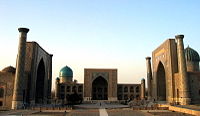
In 1218, Genghis Khan sent ambassadors and merchants to the city of Otrar, on the northeastern confines of the Khwarizm shahdom. The governor of Otrar had these envoys executed. Genghis attacked Otrar in 1219, Samarkand and other cities of the northeast.
Genghis' grandson, Hulagu Khan, finished the invasions that Genghis had begun when he defeated Khwarzim Empire, Baghdad, and much of the rest of the Middle East from 1255 to 1258. Persia temporarily became the Ilkhanate, a division of the vast Mongol Empire.
In 1295, after Ilkhan Mahmud Ghazan converted to Islam, he forced Mongols in Persia to convert Islam. The Ilkhans patronized the arts and learning in the fine tradition of Iranian Islam; indeed, they helped to repair much of the damage of the Mongol conquests.
In 1335, the death of Abu Sa'id, the last well-recognized Ilkhan, spelled the end of the Ilkhanate. Though Arpa Ke'un was declared Ilkhan his authority was disputed and the Ilkhanate was splintered into a number of small states. This left Persia vulnerable to conquest at the hands of Timur the Lame or Tamerlane, a Central Asian conqueror seeking to revive the Mongol Empire. He ordered the attack of Persia beginning around 1370 and robbed the region until his death in 1405. Timur is known for his brutality; in Isfahan, for instance, he was responsible for the murder of 70,000 people so that he could build towers with their skulls. He conquered a wide area and made his own city of Samarkand rich, but he failed to forge a lasting empire. The Persian Empire was essentially in ruins.
For the next hundred years Persia was not a unified state. It was ruled for a while by descendants of Timur, called the Timurid emirs. Toward the end of the 15th century, Persia was taken over by the Emirate of the White Sheep Turkmen (Ak Koyunlu). But there was little unity and none of the sophistication that had defined Iran during the glory days of Islam.
Safavid Persian Dynasty (1500–1722)
The Safavid Dynasty hailed from the town of Ardabil in the region of Azarbaijan. The Safavid Shah Ismail I overthrew the White Sheep (Akkoyunlu) Turkish rulers of Persia to found a new native Persian empire. Ismail expanded Persia to include all of present-day Azerbaijan, Iran, and Iraq, plus much of Afghanistan. Ismail's expansion was halted by the Ottoman Empire at the Battle of Chaldiran in 1514, and war with the Ottomans became a fact of life in Safavid Iran.
Safavid Persia was a violent and chaotic state for the next seventy years, but in 1588 Shah Abbas I of Safavid ascended to the throne and instituted a cultural and political renaissance. He moved his capital to Isfahan, which quickly became one of the most important cultural centers in the Islamic world. He made peace with the Ottomans. He reformed the army, drove the Uzbeks out of Iran and into modern-day Uzbekistan, and (with English help) recaptured the island of Hormuz from the Portuguese. Abdur Razzaq was the Persian ambassador to Calicut, India, and wrote vividly of his experiences there.
The Safavids were followers of Shi'a Islam, and under them Persia (Iran) became the largest Shi'a country in the Muslim world, a position Iran still holds today.
Under the Safavids Persia enjoyed its last period as a major imperial power. In 1639, a final border was agreed upon with the Ottoman Empire with the Treaty of Qasr-e Shirin; which delineates the border between the Republic of Turkey and Iran and also that of between Iraq and Iran, today.
Persia and Europe (1722–1914)
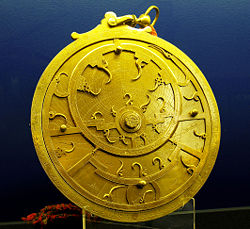
In 1722, the Safavid state collapsed. That year saw the first European invasion of Persia since the time of Heraclius: Peter the Great, Emperor of Imperial Russia, invaded from the northwest as part of a bid to dominate central Asia. Ottoman forces accompanied the Russians, successfully laying siege to Isfahan.
The Russians conquered the city of Baku and its surroundings. The Turks also gained territory. However, the Safavids were severely weakened, and that same year (1722), the Afghans launched a bloody battle in response to the Safavids' attempts on trying to forcefully convert them from Sunni to Shi'a sect of Islam. The last Safavid shah was executed, and the dynasty came to an end.
The Persian empire experienced a temporary revival under Nader Shah in the 1730s and 1740s. Nadir checked the advances of the Russians and defeated the Afghans, later recaptured all of Afghanistan. He also launched successful campaigns against the nomadic khanates of Central Asia, and the Arabs of Oman. He also recaptured the territories lost to the Ottomans and invaded the Ottoman Empire. In 1739, he attacked and looted Delhi, the capital of Moghul India. When Nadir Shah was assassinated, the empire was ruled by the Zand dynasty. Iran was left unprepared for the worldwide expansion of European colonial empires in the late 18th century and throughout the 19th century.
Persia found relative stability in the Qajar dynasty, ruling from 1779 to 1925, but lost hope to compete with the new industrial powers of Europe; Persia found itself sandwiched between the growing Russian Empire in Central Asia and the expanding British Empire in India. Each carved out pieces from the Persian empire that became Bahrain, Azerbaijan, Turkmenistan, Armenia, Georgia and Uzbekistan amongst other previous provinces.
Although Persia was never directly invaded, it gradually became economically dependent on Europe. The Anglo-Russian Convention of 1907 formalised Russian and British spheres of influence over the north and south of the country, respectively, where Britain and Russia each created a " sphere of influence", where the colonial power had the final "say" on economic matters.
At the same time Mozzafar-al-Din shah had granted a concession to William Knox D'Arcy, later the Anglo-Persian Oil Company, to explore and work the newly-discovered oil fields at Masjid Soleiman in southwest Persia, which started production in 1914. Winston Churchill, as First Sea Lord to the British Admiralty, oversaw the conversion of the Royal Navy to oil-fired battleships and partially nationalized it prior to the start of war. A small Anglo-Persian force was garrisoned there to protect the field from some hostile tribal factions.
World War I and the interbellum (1914–1935)
Persia was drawn into the periphery of World War I because of its strategic position between Afghanistan and the warring Ottoman, Russian, and British Empires. In 1914 Britain sent a military force to Mesopotamia to deny the Ottomans access to the Persian oilfields. The German Empire retaliated on behalf of its ally by spreading a rumour that Kaiser Wilhelm II of Germany had converted to Islam, and sent agents through Iran to attack the oil fields and raise a Jihad against British rule in India. Most of those German agents were captured by Persian, British and Russian troops who were sent to patrol the Afghan border, and the rebellion faded away. This was followed by a German attempt, to abduct Ahmad Shah Qajar. This was foiled at the last moment.
In 1916 the fighting between Russian and Ottoman forces to the north of the country had spilled down into Persia; Russia gained the advantage until most of her armies collapsed in the wake of the Russian Revolution of 1917. This left the Caucasus unprotected, and the Caucasian and Persian civilians starving after years of war and deprivation. In 1918 a small force of 400 British troops under General Dunsterville moved into the Trans-Caucasus from Persia in a bid to encourage local resistance to German and Ottoman armies who were about to invade the Baku oilfields. Although they later withdrew back into Persia, they did succeed in delaying the Turks access to the oil almost until the Armistice. In addition, the expedition’s supplies were used to avert a major famine in the region, and a camp for 30,000 displaced refugees was created near the Mesopotamian frontier.
In 1919, northern Persia was occupied by the British General William Edmund Ironside to enforce the Turkish Armistice conditions and assist General Dunsterville and Colonel Bicherakhov contain Bolshevik influence (of Mirza Kuchak Khan) in the north. Britain also took tighter control over the increasingly lucrative oil fields.
In 1925, Reza Shah Pahlavi seized power from the Qajars and established the new Pahlavi dynasty, the last Persian monarchy before the establishment of the Islamic Republic. However, Britain and the Soviet Union remained the influential powers in Persia into the early years of the Cold War.
On March 21, 1935, Iran was officially accepted as the new name of the country. After Persian scholars' protests to this decision on the grounds that it represented a break with their classical past and seemed to be unduly influenced by the "Aryan" propaganda from Nazi Germany. In 1953 Mohammad Reza Shah announced both names "Iran" and "Persia" could be used.
Significance of history of Persia
The role of Persia (Iran) in history is highly significant; In fact, the German philosopher Georg Wilhelm Friedrich Hegel considered the ancient Persians to be the first historic people and stated thus: "In Persia first arises that light which shines itself and illuminates what is around...The principle of development begins with the history of Persia; this constitutes therefore the beginning of history".
And Richard Nelson Frye further verifies:
- "Few nations in the world present more of a justification for the study of history than Iran."
Timeline
|
|
Persia in fiction
- The Persian Empire is the seat of power for the sultan Shahryar, husband of Scheherazade in the 1001 Nights — though the tales themselves span from China to the Middle East and even parts of North Africa.
- Prince of Persia is a puzzle and action-based video game series set in a mythological version of Ancient Persia.
- The historical fantasy The Dragon of the Ishtar Gate by L. Sprague de Camp is set in Babylon during the last few years of Xerxes I reign.
- The historical novel Creation by Gore Vidal, about a Persian diplomat who travels the known world studying religious beliefs on behalf of Darius the Great.
- The Prince of Nothing books by R. Scott Bakker, set in a fictional land that draws influence from Hellenistic Greece, Scythia, and the Persian Empire.
- Gates of Fire, by Steven Pressfield and 300 by Frank Miller, about the Battle of Thermopylae.
- Mary Renault's second book in her trilogy on Alexander the Great. The Persian Boy, narrated by Bagoas set during Alexander the Great's reign of Persia.
- Robert E. Howard's short story The Shadow of the Vulture, featuring Red Sonya, is set in the Safavid Dynasty, as she seeks vengeance on an Ottoman sultan. It was published in The Magic Carpet Magazine, a magazine that was known for their stories set in the Orient.
- Godless Man, by Paul Doherty - An historical mystery, set during the reign of Alexander the Great (who is also a major character). Telamon, friend and physician of Alexander, must unravel the threatening murders by a high-ranking Persian spy only known as "the Centaur". Second part of a trilogy.
- Hadassah: One Night With the King by Tommy Tenney, tells the story of Esther, Queen of Persia.
- Gardens of Light by Amin Maalouf
- Persia: The Land of the Magi or the Home of the Wisemen by Samuel K. Nweeya
- The Sassanid Persian Empire was featured as the ally of Byzantium in the jointly written six book long Bellisarius Saga by David Drake and Eric Flint.
- The Battle of Thermopylae, part of the Persian invasion of Greece in 480 BC, is dramatically retold in Frank Miller's comic book (and subsequent film) 300 and features such historical figures as Persian King Xerxes I and Spartan King Leonidas I.
- Jamshid and the Lost Mountain of Light by Howard Lee - A children's book which draws heavily from Persian mythology
- Historical fiction Roxana Romance by A. J. Cave chronicles the life of Roxana, wife of Alexander the Great, after the fall of the imperial Achaemenids.
